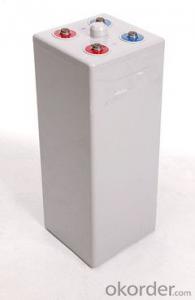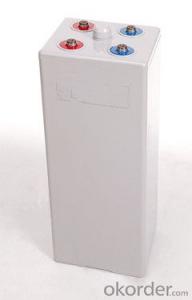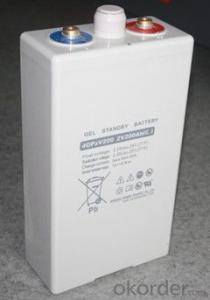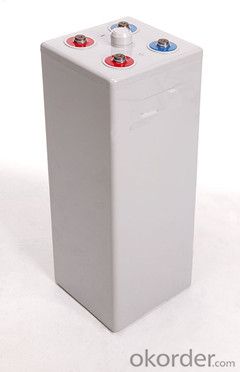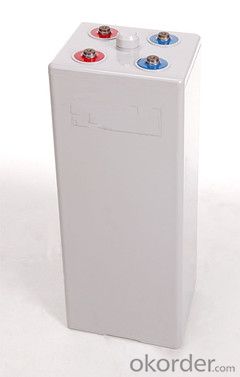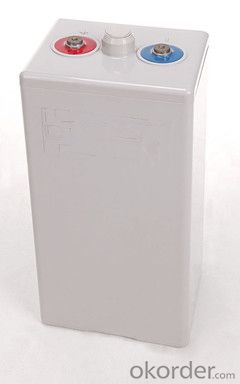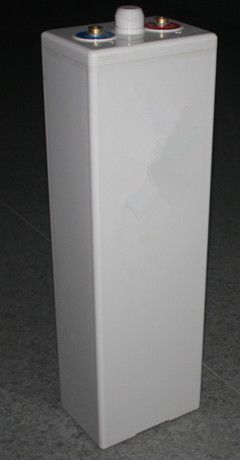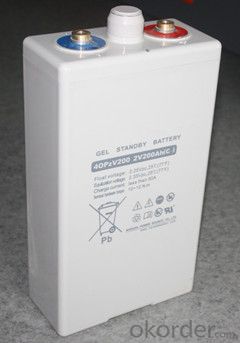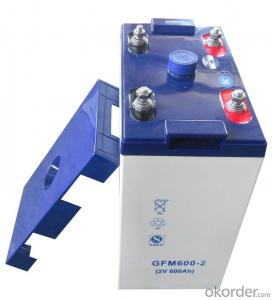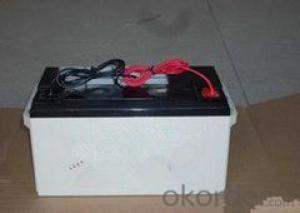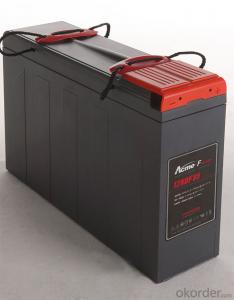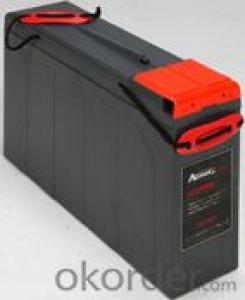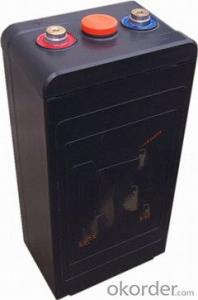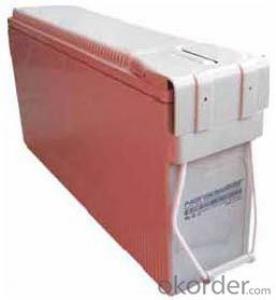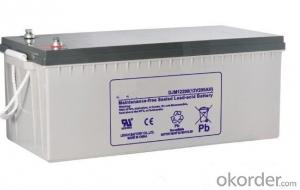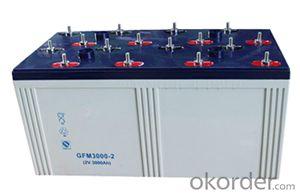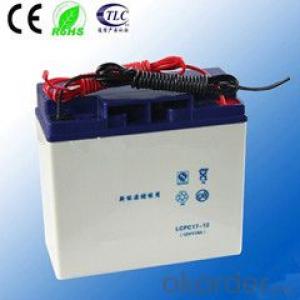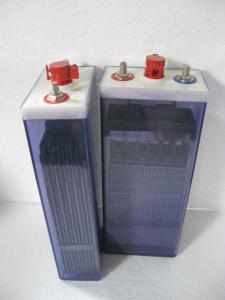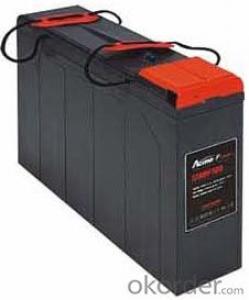Gel Technology Battery Ares(OPzV) Series 10OPzV 1000
- Loading Port:
- Shanghai
- Payment Terms:
- TT OR LC
- Min Order Qty:
- 1000 unit
- Supply Capability:
- 5000000 unit/month
OKorder Service Pledge
OKorder Financial Service
You Might Also Like
Gel Technology Battery Ares(OPzV) Series Introduction
Ares(OPzV) range battery adopts traditional gel technology .
The products are designed as standby power for communication, power, military and broadcast and television system with excellent deep cycle performance. The design float life is 18+ at 77oF(25oC)
The Ares(OPzV) range batteries are ensured the quality with NARADA's QA system according to the ISO9001 and ISO14001 standard.
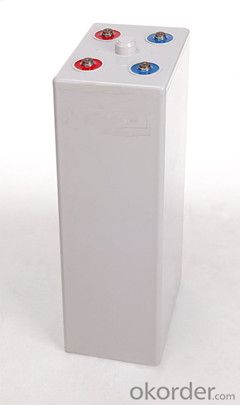
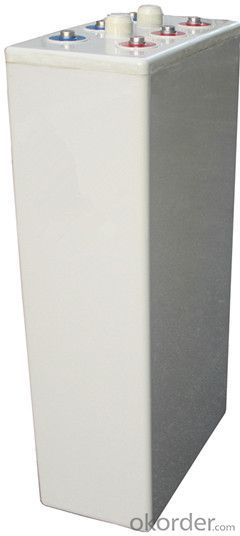
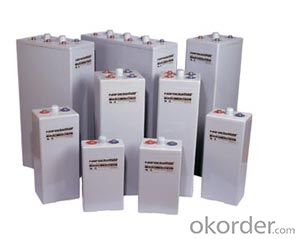
Type: | 10OPzV 1000 | |
Voltage: | 2V | |
Nominal Capacity: | 1000Ah(C10) | 1000Ah(10 hours rate:) |
Length: | 233mm | |
Width: | 210mm | |
Height: | 646mm | |
Height with termial: | 678mm | |
Weight: | 80Kg |
Gel Technology Battery Ares(OPzV) Series Technical Feature:
Traditional gel technology
18+ years design life under floating application and cycle life is above 1200 at 80% DOD under temperature 25 oC.
Reliable seal performance, no acid spillage, recombination efficiency reach 99.9%
Initial capacity above 100%, the remaining capacity above 94% after storage for 3 months (25oC)
low float charge voltage. design (2.23V/cell, 25oC), extremely consistent float charge voltage
Flexible connectors and convenient installation
Gel Technology Battery Ares(OPzV) Series Compliant Standards :
IEC60896-21/22
Din standard
UL
Manufactured under system ISO9001(TUV) and ISO14001(DNV) by Narada
Gel Technology Battery Ares(OPzV) Series Battery Installation Compliant with:
EN 50272-2 or local equivalents
Gel Technology Battery Ares(OPzV) Series Main Application:
Telecommunications
Motive power applications
Railway and mining markets
Uninterruptible power supply (UPS)
Solar energy storage application
Other applications to provide integrated stored energy system
Gel Technology Battery Ares(OPzV) Series Products Characteristics:
Recommended float charge voltage for 2V battery: 2.23Vpc at 25oC(77oF)
Self discharge rate :< 2% per month at 25oC(77oF)
Design life: 18+ years at 25oC(77oF)
Shelf life: 6 months at 25oC(77oF)
Valve regulated system, no water addition needed
FAQ
![]() What is sulfation of batteries?
What is sulfation of batteries?
Sulfation is the formation or deposit of lead sulfate on the surface and in the pores of the active material of the batteries' lead plates. If the sulfation becomes excessive and forms large crystals on the plates, the battery will not operate efficiently and may not work at all. Common causes of battery sulfation are standing a long time in a discharged condition, operating at excessive temperatures, and prolonged under or over charging.
![]() How long a battery can last?
How long a battery can last?
The service design life of a battery are vary considerably with how it is used, how it is maintained and charged, temperature, and other factors.
![]() Do batteries self-discharge when not in use?
Do batteries self-discharge when not in use?
All batteries, regardless of their chemistry, self-discharge. The rate of self-discharge depends both on the type of battery and the storage temperature the batteries are exposed to. However, for a good estimate, Narada batteries self-discharge approximately 4% per week at 80ĄăF.
- Q: How to repair the battery?
- Maintain the battery before, first of all to clean up the battery appearance of the dust, remove the terminal above the stain and corrosion.
- Q: How is the capacity of the battery defined?
- The capacity of the battery unit is AH (safety) is the product of current and time.
- Q: What is the difference between a maintenance-free battery and a conventional battery?
- Lead-acid battery is composed of positive and negative plates, partitions, shell, electrolyte and wiring pile head and other components, the discharge of the chemical reaction is to rely on positive electrode active substances (lead dioxide and lead) and negative plate active substances (sponge Pure lead) in the electrolyte (dilute sulfuric acid solution) under the action, which plate grid, the traditional battery lead and antimony alloy manufacturing, maintenance-free battery is made of lead calcium alloy, the former with antimony, the latter with calcium, This is the fundamental difference between the two points.
- Q: How to determine the battery is good or bad?
- Observe the battery electrolyte is turbid, turbidity that the battery positive plate softening. Observe the bottom of the battery whether there is sediment, if the plate off the battery capacity has been inadequate. Hand hit the battery two electrode piles If you hear an empty voice that pole pile and plate break. With a thick wire short-circuit positive and negative pile observation of the battery filling holes, such as the discovery of a bubble appears that the interval has been damaged.
- Q: How to deal with waste batteries?
- In addition to lead-acid batteries, all kinds of batteries are dissolved in sulfuric acid, and then by means of ion resin from the solution to extract a variety of metals, raw materials obtained in this way than the heat treatment method is pure, so the market price is higher, and the battery contains 95% of the various substances can be extracted.
- Q: Maintenance-free battery how to detect it?
- Keep the battery surface clean. If the discovery of solid oxide on the pole, it should be timely with hot water pouring, to be removed, so as not to affect the pole and the terminal between the continuity. After cleaning up, wipe the battery surface, in the pole and the terminal cast on the butter to ensure that the pole is not oxidized.
- Q: What are the advantages of maintenance-free batteries?
- Maintenance-free battery because of its normal charging voltage, the electrolyte only produce a small amount of gas, so throughout the use of the need for the addition of distilled water, in the normal charging system, do not need to remove the charge from the removal. But in the maintenance of the proportion of its electrolyte should be checked.
- Q: 80ah how much battery storage capacity?
- Is 80AH. Understood to discharge at 80 amps for about 1 hour (but not to say that after 1 hour is finished, there is still electricity). In theory, this is your battery power.
- Q: What kind of battery is divided into?
- Maintenance-free battery due to its own structure on the advantages of electrolyte consumption is very small, in the life of the basic need not add distilled water. It also has a shock, high temperature, small size, self-discharge characteristics of the general life is generally ordinary Twice the battery. There are two kinds of maintenance-free batteries on the market.
- Q: What is a maintenanceable battery?
- This is relative to a maintenance-free battery. Maintenance of the battery needs to be supplemented with electrolyte to ensure work, while maintenance-free is not required.
Send your message to us
Gel Technology Battery Ares(OPzV) Series 10OPzV 1000
- Loading Port:
- Shanghai
- Payment Terms:
- TT OR LC
- Min Order Qty:
- 1000 unit
- Supply Capability:
- 5000000 unit/month
OKorder Service Pledge
OKorder Financial Service
Similar products
Hot products
Hot Searches
